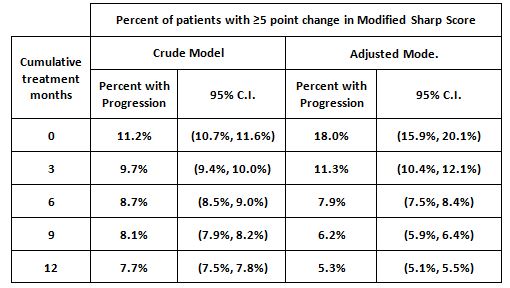Session Information
Session Type: ACR Poster Session C
Session Time: 9:00AM-11:00AM
Background/Purpose: While tumor necrosis factor inhibitors (TNFi) have been proven to reduce progression of structural joint damage in rheumatoid arthritis (RA) in randomized clinical trials, this aspect of effectiveness has not been studied in real world clinical practice. We evaluated the relationship between cumulative exposure to TNFi therapy and progression of joint damage following initiation of TNFi therapy in US Veterans.
Methods: Veterans with RA who initiated TNFi use after at least six months of enrollment in Veterans Affairs (VA) health care were eligible for this study. Subjects were US Veterans with VA care between January 1, 2006 and June 30, 2016 with bilateral baseline hand x-rays during the interval between six months prior to and one month after TNFi initiation and follow-up bilateral hand x-rays taken between 10 and 18 months after TNFi initiation. Subjects with non-TNFi biologic drug exposure prior to TNFi initiation or between baseline and follow-up x-rays were excluded. Change in the modified Sharp Score (mSS) on hand radiographs that were interpreted by a single evaluator, blinded to TNFi history and sequence of x-rays, was assessed relative to cumulative TNFi exposure calculated from VA pharmacy data. A worsening of mSS of ≥5 points was considered clinically significant to account for reader variability. The population fraction with clinically significant change in mSS was explored using marginal structural models (MSM) with inverse probability of treatment weights (IPTW). Bootstrapping was used to compute 95% confidence intervals (CI.) Baseline patient disease characteristics (e.g., age, seropositive status, smoking history, co-morbidities, concurrent medication, and baseline mSS) and time-varying covariates (ESR, C-reactive protein, and prednisone treatment) were deemed potential confounders and included as covariates in the MSM.
Results: There were 250 patients from 81 sites enrolled. The population’s baseline demographic features were: age 58 ±11 years, 81% male, 68% positive for rheumatoid factor, and 65% positive for anti-cyclic citrullinated peptide antibody (aCCP). Baseline mSS was 19.5±33.2 (median 8, range 0 to 214). The mean change in mSS was 0.5±4.6 (median 0, range -19 to 45). Increases in cumulative TNFi exposure were associated with decreases in mSS. In comparison to patients with less than one month of TNFi exposure, patients with 12-months of cumulative exposure exhibited less radiographic progression for weighted analysis.
Conclusion: While progression of radiographic changes as measured by mSS were small in the first year of use, increased cumulative TNFi exposure was associated with less progression of joint damage in US Veterans. These results demonstrate real-world effectiveness and support the findings of reduced radiographic progression with TNFi therapy reported in randomized clinical trials.
To cite this abstract in AMA style:
Cannon G, Erickson AR, Teng MS CC, Huynh T, Wade SW, Stolshek BS, Collier D, Mutebi A, Sauer PhD BC. Increased Cumulative Exposure to Tumor Necrosis Factor Inhibitors Reduces Radiographic Progression in US Veterans with Rheumatoid Arthritis in Real World Clinical Practice [abstract]. Arthritis Rheumatol. 2017; 69 (suppl 10). https://acrabstracts.org/abstract/increased-cumulative-exposure-to-tumor-necrosis-factor-inhibitors-reduces-radiographic-progression-in-us-veterans-with-rheumatoid-arthritis-in-real-world-clinical-practice/. Accessed .« Back to 2017 ACR/ARHP Annual Meeting
ACR Meeting Abstracts - https://acrabstracts.org/abstract/increased-cumulative-exposure-to-tumor-necrosis-factor-inhibitors-reduces-radiographic-progression-in-us-veterans-with-rheumatoid-arthritis-in-real-world-clinical-practice/

